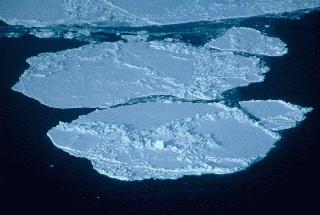Compare Images of Antarctic Sea Ice Extent Side-by-side
The images below show sea ice in the Southern Hemisphere. Select images from the popup menus to compare two images side-by-side.
Try this:
- compare the sea ice in February and September for the same year
- compare the sea ice in February for two different years
- compare the sea ice in September for two different years
- click here if you want to look at sea ice in the northern hemisphere
In the Southern Hemisphere (around the South Pole and Antarctica) the sea ice
reaches its maximum extent in early spring, at the end of the long, cold winter.
September is usually the month with the most sea ice.
The ice pack melts and breaks up over the summer. February is usually the month
with the least sea ice (in the Southern Hemisphere).
The pink line in the images shows the average (from 1979 to 2000) edge of the ice pack for a particular month.
Click here
to view an animation
of the annual changes in sea ice extent in the Southern Hemisphere for a seven-year
period (2002 through 2008). Click here
to see the predictions
that global climate models make about future changes in sea ice extent.
Go to the NSIDC web site to:
You might also be interested in:

Sea ice is frozen seawater. It can be several meters thick and it moves over time. Although the salts in the seawater do not freeze, pockets of concentrated salty water become trapped in the sea ice when
...more
What Will You Find There? South of the Antarctic Circle (at 66.5°S latitude) you will find the continent of Antarctica surrounded by the Southern Ocean, the geographic South Pole and the magnetic South
...more
NASA's Earth Observatory has recently started making images of the entire surface of the Earth every month. There are no clouds in the images because they combine many pictures taken at different times
...more
There are two oceans in Earth’s polar regions: the Arctic Ocean, which occupies most of the north polar region, and the Southern Ocean, which surrounds the continent of Antarctica in the south polar region.
...more
The Southern Ocean is a bit different. Many mapmakers do not even recognize it as an ocean. The Southern Ocean (sometimes known as the Antarctic Ocean or South Polar Ocean) surrounds Antarctica in the
...more
Windows to the Universe and other educational programs of the University Corporation for Atmospheric Research Office of Education and Outreach invite you to explore Earth's polar regions with your students
...more
Dive into one of our new polar activities or games! Animation showing Annual Variation of Sea Ice Extent in the Arctic Animation showing Annual Variation of Sea Ice Extent in the Antarctic Changing Planet:
...more












